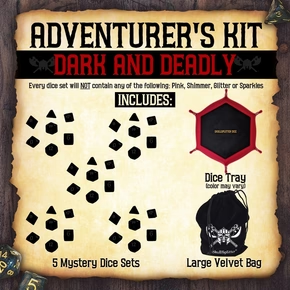
Fall Damage 5e
A Complete Guide for Plummeting to Your Doom
So, you’ve slipped off the edge of a cliff and are plummeting to your death, we’ve all been there. Falls and great heights are some of the few things that can outright kill a player and most veteran TTRPG players can recount at least one or two characters that have met an untimely end with an inopportune slip or badly judged jump. Now that you’re falling though, is there hope? Do you have any options? How much is this going to hurt exactly? Watch as your life flashes before your eyes and we go through everything you need to know.
Table of Contents:
How to Calculate Fall Damage 5e
Before we get into what to do when you find yourself falling, let’s go over how fall damage actually works. To start with, here’s the raw fall damage rules from the basic rules:
“A fall from a great height is one of the most common hazards facing an adventurer. At the end of a fall, a creature takes 1d6 bludgeoning damage for every 10 feet it fell, to a maximum of 20d6. The creature lands prone, unless it avoids taking damage from the fall.”
So far, so good, so much damage. Fall 30 feet, take 3d6 bludgeoning damage. This means that if you get pushed out of an airship or off a mountain (anything with a several hundred foot drop), you’ll be taking the maximum of 20d6 bludgeoning damage once you finally hit the bottom. For a quick reference, that’s an average of 70 damage, with a potential minimum of 20, and maximum of 120.
But that’s just a straightforward fall, this is D&D after all and practically anything can happen. Let’s go through some of the common modifiers to this simple rule.
Rate of Falling
Let’s say you’re falling down some impossibly deep pit, or are in the middle of the plane of air or something and there isn’t a bottom to reach? Well, you don’t fall instantly. When you’re extremely high up, you may need to use the following optional rule rule:
“When you fall from a great height, you instantly descend up to 500 feet. If you’re still falling on your next turn, you descend up to 500 feet at the end of that turn. This process continues until the fall ends, either because you hit the ground or the fall is otherwise halted.”
So, if you fall from a height of exactly 501 feet, you’ll get a round to react and possibly save yourself. Obviously, it will only be relevant on the highest of falls but remember this when we get to ways of surviving a fall.
Flying Creatures and Falling
It may sound odd at first, but what if a flying creature starts falling? What happens if your magical flight suddenly runs out or you finally land a shot on that no-good pixie? Xanathar’s gave us some solid optional rules for all the interactions between falling and fly speeds:
“A flying creature in flight falls if it is knocked prone, if its speed is reduced to 0 feet, or if it otherwise loses the ability to move, unless it can hover or it is being held aloft by magic, such as the fly spell.
If you’d like a flying creature to have a better chance of surviving a fall than a non-flying creature does, use this rule: subtract the creature’s current flying speed from the distance it fell before calculating falling damage. This rule is helpful to a flier that is knocked prone but is still conscious and has a current flying speed that is greater than 0 feet. The rule is designed to simulate the creature flapping its wings furiously or taking similar measures to slow the velocity of its fall.
If you use the rule for rate of falling in the previous section, a flying creature descends 500 feet on the turn when it falls, just as other creatures do. But if that creature starts any of its later turns still falling and is prone, it can halt the fall on its turn by spending half its flying speed to counter the prone condition (as if it were standing up in midair).”
They phrase all that somewhat awkwardly, but essentially this set of rules presents us with “THE RULES” and an optional rule you can use instead.
The “standard” rules are that flying creatures fall just as fast as other creatures (500 feet a round), but if they’re still falling after the first 500 feet they can stop their descent with half of their movement similar to spending half of your movement to stand up from prone.
The optional rule subtracts the flying creature’s fly speed from the “distance fallen” when you count up the damage they take.
Say the monk pops an evil wizard with a stunning strike midair and stuns them, dropping them from their previous magical fly speed of 60 feet down to 0, which means they drop like a log.
If the evil wizard was 100 feet up, we would subtract their fly speed of 60 feet, leaving us with a 40-foot difference. We know from the falling damage rules that our poor evil wizard should take 1d6 bludgeoning damage per 10 feet fallen, so he takes 4d6.
However, this rule is completely optional, and DMs could just as easily say the wizard can’t stop himself from falling at all while stunned, and should take the full 10d6, ouch.
Falling into Water
You leap from the cliff into the ocean below, what happens? Do you simply dive in? Do you need to make an Athletics check or something? Is it always an unceremonious and horrifying belly flop? Sadly, we don’t have an official rule for this, despite how often it comes up.
Raw rules as written, falling into water does just as much damage as falling onto concrete (and to be fair, there’s a lot of physics to back that up). Strangely, this means that even a 10-foot drop (an extremely low dive by diving standards) into a pool should deal 1d6 bludgeoning damage.
I want to reiterate there is no official answer to this question, but there are several common fixes:
Athletics Diving
An extremely common way to have your characters “safely” dive into water is to have them roll an Athletics check. The result of each check is how much of the fall each character can ignore when calculating damage.
For example, an Athletics check result of 10 or higher would ignore 10 feet of falling, a result of 20 or higher would ignore 20 feet of falling, and so on.
This method makes it extremely likely that most characters can ignore at least 10 feet worth of falling into water, but extreme athletes may be able to ignore 20 or even 30 foot dives, while every once in a while a character has an extremely painful and embarrassing belly flop.
Ignore 20
A much simpler and still common fix is to automatically ignore the first 20 feet worth of falling when falling into water. Conceptually this works pretty well, if you drop somebody 100 feet into the ocean, they’re probably dead, but there are real life diving boards at 30 and 40 feet. Functionally this works a lot like the “Athletics Diving” method but is a bit kinder to the lower Strength members of the party.
Half Damage
Finally, the “half damage” method has some real credibility, as it was an unofficial suggested fix to the problem proposed by 5e designer Jeremy Crawford. As he put it:
“There's no official rule for falling into water. As DM, halving the falling damage is what I typically do.”
This still presents the conceptually odd prospect of taking damage for a 10-foot jump into a pool but is kinder for the real big jumps. Using this method, even a thousand-foot fall into the ocean would only inflict 10d6 bludgeoning damage.
How to Prevent Fall Damage 5e
5e is rather stingy with options for falling. There’s no “base check” you can make to reduce your falling damage, it just happens. The few options that we do get are really good at mitigating or preventing that damage though, let’s go through them:
Feather Fall
This is the catch-all that everybody is going to first bring up once fall damage is mentioned. Feather fall is a 1st level spell available to Bards, Sorcerers, and Wizards. Feather fall turns a leap off the cliff for your entire party from certain doom to a gentle glide down to the bottom. It’s cast as a reaction, so you can instantly cast it if you find yourself or one of your friends falling. Simply put, if you or one of your allies has feather fall, falling damage just shouldn’t be a problem anymore.
Be a Monk
Not a Bard, Sorcerer, or Wizard? How about a monk? Once you reach your 4th level in Monk, you gain the ability slow fall. This reduces the amount of damage you take from falling by 5 times your monk level (so minimum 20 when you get the ability). It takes your reaction, but unlike some previous editions and systems, it has no limitations. As we previously figured out, the average damage for even a thousand-foot fall is about 70 damage. This means that a 14th level monk can go skydiving without a parachute and reasonably expect to walk away unscathed!
Fly You Fool!
If you have a natural fly speed somehow, you’re golden. Unless you get whammed hard and have your movement speed removed you should be “immune” to the risk of falling. If however you’re relying on magical flight (such as from the spell fly) that isn’t active all the time, you may want to proactively cast it if you’re in a “potential fall” situation. Unlike feather fall, you can’t cast fly and most other spells that grant you flight as a reaction. This means if you get shoved off a cliff, you’re going to most likely reach the bottom with a splat without having the opportunity to cast it on the way down. If in doubt, cast your flying spell ahead of time.
Cat’s Grace
If you’re a Bard, Cleric, Druid, Sorcerer, Artificer, or Paladin of the oath of glory, then you have access to the often missed and underutilized 2nd level spell enhance ability. Enhance ability has 6 different modes, each one grants advantage on checks of a different ability score, and many of them have little bonus effects depending on the stat. Cat’s Grace is the dexterity mode, which happens to make the target immune to falling damage from 20 feet or less. This sadly doesn’t “stack” and doesn’t do anything if you fall from say 30 feet. But if you’re in a situation that risks 1 to 2 story falls like a rooftop chase or a battle in the tree canopy, this spell’s the ticket.
--
Enjoy this Guide? You May Also Like:
Need a New Dice Set? Check out our polyhedral dice sets here. They are perfect for every gamer as a gift or just treating yourself!
Thinking about other classes? Check out our giant list of D&D 5e Tools and Tips here.
New to find a D&D Group? Check out our guide on How to Find a D&D Group.
Want to wield two swords like Drizzt? Check out our Two Weapon Fighting 5e Guide!
Stuck during character creation? Check out the Point Buy Blog post to get unstuck!

Disclaimer
Last updated: January 27, 2019
The information contained on www.SkullSplitterDice.com website (the "Service") is for general information purposes only.
www.SkullSplitterDice.com is a participant in the Amazon Services LLC Associates Program, an affiliate advertising program designed to provide a means for sites to earn advertising fees by advertising and linking to Amazon.com. (source: Section 5)
Blueshift Nine, LLC assumes no responsibility for errors or omissions in the contents on the Service.
In no event shall Blueshift Nine, LLC be liable for any special, direct, indirect, consequential, or incidental damages or any damages whatsoever, whether in an action of contract, negligence or other tort, arising out of or in connection with the use of the Service or the contents of the Service. Blueshift Nine, LLC reserves the right to make additions, deletions, or modification to the contents on the Service at any time without prior notice.
Blueshift Nine, LLC does not warrant that the Service is free of viruses or other harmful components.
Affiliate disclaimer
This affiliate disclosure details the affiliate relationships of Blueshift Nine, LLC with other companies and products.
Some of the links are "affiliate links", a link with a special tracking code. This means if you click on an affiliate link and purchase the item, we will receive an affiliate commission.
The price of the item is the same whether it is an affiliate link or not. Regardless, we only recommend products or services we believe will add value to our readers.
By using the affiliate links, you are helping support the Service, and we genuinely appreciate your support.
Affiliate advertising programs that the Service uses are:
- Amazon Services LLC Associates Program
- As an Amazon Associate, I earn from qualifying purchases.
- Blueshift Nine, LLC is a participant in the Amazon Services LLC Associates Program, an affiliate advertising program designed to provide a means for sites to earn advertising fees by advertising and linking to Amazon.com or endless.com, MYHABIT.com, SmallParts.com, or AmazonWireless.com.
- Pages on this Service may include affiliate links to Amazon and its affiliate sites on which the owner of this Service, Blueshift Nine, LLC, will make a referral commission.




